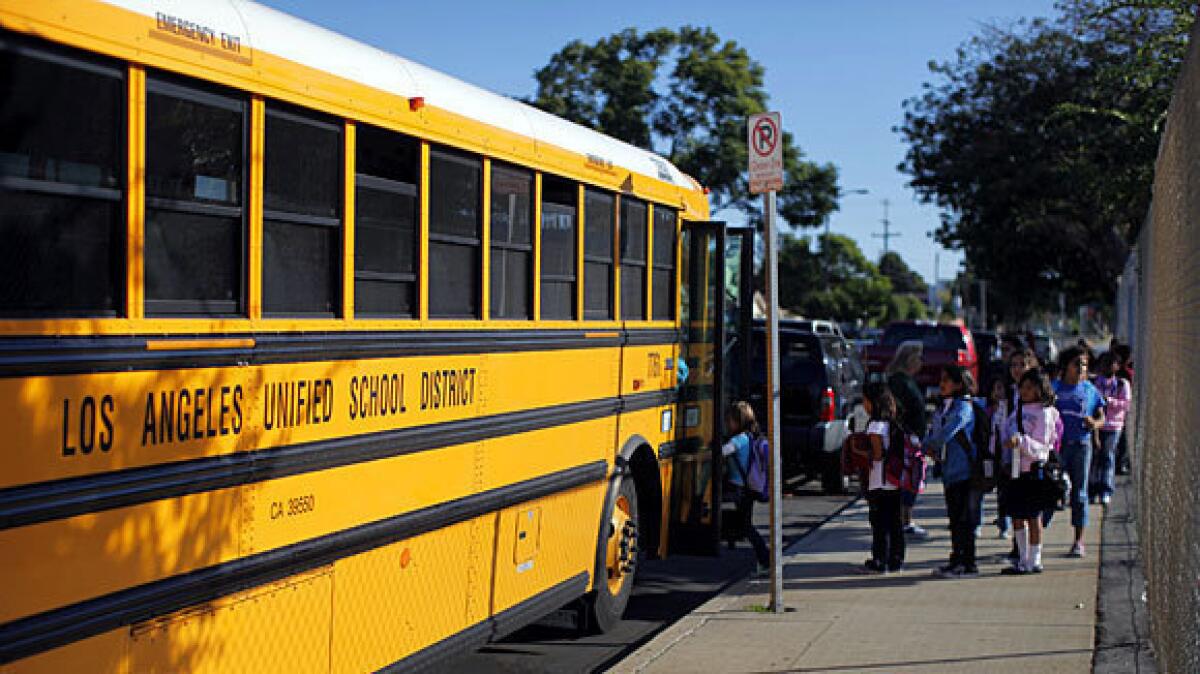School programs in L.A. to get $1.7 million in grants

- Share via
Several Los Angeles schools, hit hard by budget cuts in recent years, are set to receive $1.7 million from two foundations in a major national initiative to expand learning time for disadvantaged students.
The California Community Foundation is to announce Friday that it has received $1.5 million from the Ford Foundation to give children in impoverished communities the same enriched learning activities typically enjoyed outside school hours by their wealthier peers. The California foundation also contributed $200,000 to the efforts.
While more affluent students may be busy with music, sports, art or tutoring after school, their low-income counterparts may be watching TV, caring for siblings or working, researchers said. And 15 million youths are unsupervised between 3 p.m. and 6 p.m., a period known as the riskiest time of day for them, said Jeannie Oakes, Ford’s director of educational opportunity and scholarship programs.
“We are very concerned about the growing inequality in our country,” Oakes said. “It’s just essential for our future to do more and better for kids who are so often left behind.”
The Los Angeles grant is part of Ford’s newly launched $50-million effort in six major cities to redesign school programs and reflects a national move to increase learning as a key strategy for turning around the worst-performing schools.
More than 1,000 public schools have added time to their school day in recent years. And thousands more are set to do so, using $3.5 billion in federal grants for low-achieving campuses; 90% of approximately 4,000 grant recipients have chosen strategies that require more learning time, according to a March report by the Education Sector, aWashington, D.C.-based think tank.
From the $1.7-million total, the California Community Foundation has so far awarded $180,000 grants to two community organizations, Alliance for a Better Community and InnerCity Struggle, to work with small schools within Belmont High School and Esteban E. Torres High School.
The Los Angeles Small Schools Center received $175,000 and Los Angeles Education Partnership received $100,000 to help teachers redesign after-school activities, said Peter Rivera of the California foundation.
The money comes as deep budget cuts have slashed staff, reduced after-school programs and shortened the school year in many districts, including L.A. Unified.
Rivera and Oakes said the grants are aimed at not simply increasing seat time in classrooms but potentially redesigning the entire school day. The Education Sector report found that adding minutes to the day did not guarantee improved learning, cost hundreds of dollars more per student and, in some cases, faced union opposition.
“Less time may be a cause of poor performance, but that doesn’t mean that more time is necessarily the cure,” the report said.
Instead, Ford is encouraging grant recipients to extend learning time as part of a creative redesign of the school day or year. Brooklyn Generation School in New York, for instance, offers students smaller classes, a 200-day school year and four-week intensive sessions twice yearly that link academic learning with college and career opportunities offered by outside partners. By staggering teachers’ schedules and redesigning their work day, the school’s program adds no extra costs, Oakes said.
Los Angeles recipients are also planning to work with outside partners. The Alliance organization is working with Belmont’s health academy and the UCLA School of Nursing to link math, English, science and other academic content with nursing careers through after-school programs. InnerCity Struggle is also hoping to bring internships related to the performing arts, engineering, social justice and other small schools at Torres.
Such models are intended to spark greater excitement about school by showing students the practical applications of their academic learning and giving them more time with caring, professional adults, Oakes said.
“Adolescents vote with their feet,” she said. “Part of getting this right is making school a place of rich and engaging learning opportunities where kids are there because they want to be.”
More to Read
Sign up for Essential California
The most important California stories and recommendations in your inbox every morning.
You may occasionally receive promotional content from the Los Angeles Times.














